The Four Pillars of Off-page SEO for NopCommerce
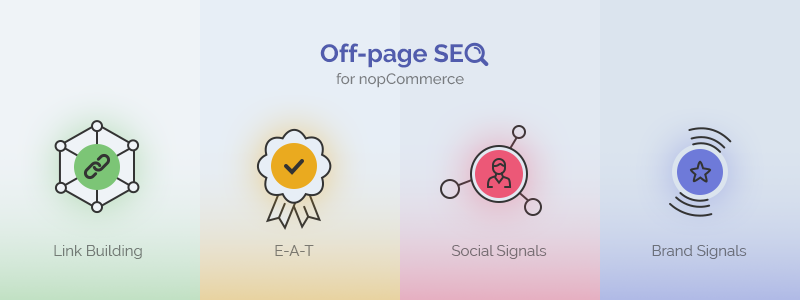
Earlier this year, we talked about on-page optimization for nopCommerce. Оn-page SEO is just part of the SEO puzzle - to be successful, you also need to do off-page optimization.
Today, we’ll have a look at the four off-page SEO fundamentals - link building, E-A-T, social signals, and brand signals. We’ll also explain what off-page SEO is, how it differs from on-page SEO, and share a ton of helpful tips along the way. Let’s commence!
Overview
What is off-page SEO
So, on-page SEO is everything you do on your website to get better search engine rankings - from meta tags optimization and image optimization to producing high-quality content, enabling SSL, and adding structured data markup to your pages.
On the other hand, off-page SEO refers to what you do outside of your website to get to the #1 spot on the SERPs. This includes everything from building quality backlinks and improving your store’s E-A-T (Expertise, Authoritativeness, Trustworthiness) to social signals and brand signals. In this article, we’ll have a look at each of these off-page SEO components.
Link building
What is link building?
Link building is the process of building/earning/acquiring backlinks, i.e., links from other websites to your nopCommerce store.
There are 3 types of backlinks:
- Editorial/natural backlinks. Let’s say you sell home decor, and a lifestyle blogger shares a link to your store in one of their posts - it’s not an affiliate link; the blogger just shared it because they bought a side table from you they love. This is an editorial backlink - you didn’t ask for it; somebody shared it because they love your products or brand.
- Outreach/manual backlinks. This time imagine you contacted the blogger - you reached out to them and asked them to share a link to your store in return for something (such as a gift card, a discount, or a complementary product). If the blogger agrees, the link would be an outreach backlink.
- Non-editorial/self-created backlinks. A self-created backlink is a backlink on another website that you created, for example, in a guest blog post.
Editorial backlinks have more SEO weight than outreach and non-editorial backlinks. But many factors affect the SEO weight of backlinks: the referring website’s domain authority and age, the linking page’s authority, the backlink’s freshness and relevance, the quality of the content on the linking page, the backlink’s anchor text, and more.
Why is link building important?
First, search engines use links to discover new pages. In other words, the more backlinks you acquire to new product pages, the faster Google will crawl them and index them.
Second, backlinks (more specifically, their number, quality, and relevance) are an important ranking signal, which makes link building a fundamental block of off-page SEO.
Third, link building can help you build and nurture valuable partnerships with influencers and business partners.
Building backlinks
There’s one rule of thumb when it comes to link building - build a diverse, natural, and relevant link profile. In other words:
- Don’t pay for backlinks and never participate in link schemes.
- Reach out to relevant websites (with high domain metrics) and influencers in your niche, i.e., if you sell cosmetics, reach out to beauty/lifestyle influencers, not people who blog about food, books, art, or travel.
- Ensure your backlinks are from different domains.
- Fix all your broken backlinks.
There are several things you can do to build backlinks:
- Create a link building campaign - This is the most direct and highly effective way to acquire backlinks.
- Create quality content that people want to share - This includes creating engaging product pages, writing helpful (and research-backed) blog posts, making outstanding videos, and more. This is a more indirect approach to link building - it requires a ton of resources, but it will show great results in the long term. However, link building tactics are a broad topic that should be discussed in another article. Today, we’ll focus on link building campaigns.
So, how can you create a successful link building campaign?
Step 1: Define what type of backlinks you need.
As a nopCommerce store owner, you need backlinks to pages that directly impact your bottom line - your product pages, category pages, On Sale/Outlet landing pages, etc.
Of course, earning backlinks to your blog posts can also be beneficial - this will increase your brand visibility and awareness, give you credibility, and help you establish yourself as an authority in your niche. Besides, if your blog posts contain links to your product pages, many people who land on them may convert.
You should also try to acquire backlinks to your homepage - this will increase your homepage authority, which will positively affect your domain authority. This, in turn, will improve your rankings - don’t forget that domain authority is a ranking factor.
Step 2: Set goals for your link building campaign
This is crucial to measuring the success of your campaign. It will also help you stay focused and organized.
Your goals should be related to your business objectives, i.e., achieving them should positively impact your overall business growth and success.
Set achievable goals - stay away from impossible deadlines or goals you don’t have the resources to achieve. Create a list of small tasks with measurable results instead of one (or several) huge and ambiguous tasks. Assign each task to a specific team member - this will establish accountability and keep your team focused and motivated. Once you’ve created a list with all your goals, prioritize them, and develop an action plan to achieve them. For better results, you can use a project management tool like Trello or Monday.
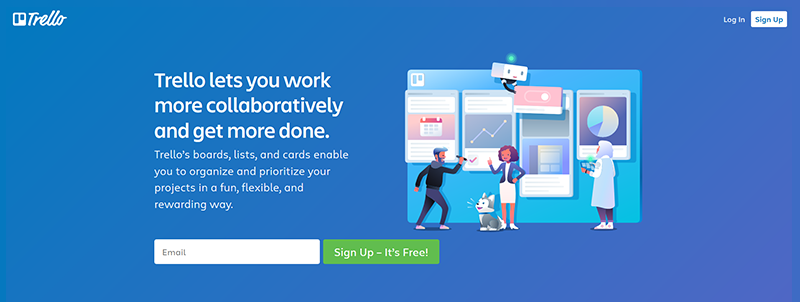
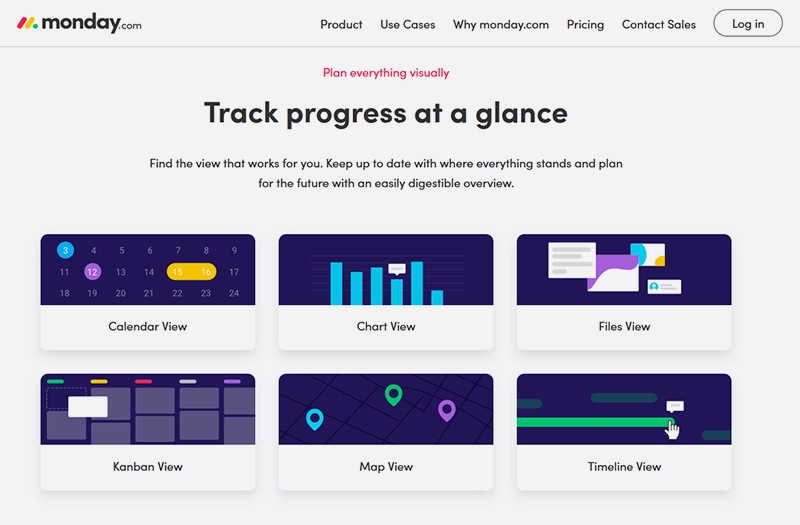
Step 3: Choose your targets
In other words, create a list of people you will reach out to and request backlinks from. To achieve this, answer the following questions:
- What type of content are your customers interested in?
- What type of bloggers and influencers share such content?
The answer to the first question is straightforward (and you probably already know it). For example, if you sell tableware, your customers would be interested in table arrangements, decor, and cooking. So, what type of influencers share such content? Home decor influencers and food influencers would be your most relevant targets.
Your next task is to find such influencers. Influencer marketing is a broad topic that should be discussed in another article. For now, you can have a look at two tools that can help you find and research influencers: BuzzSumo and BuzzStream.
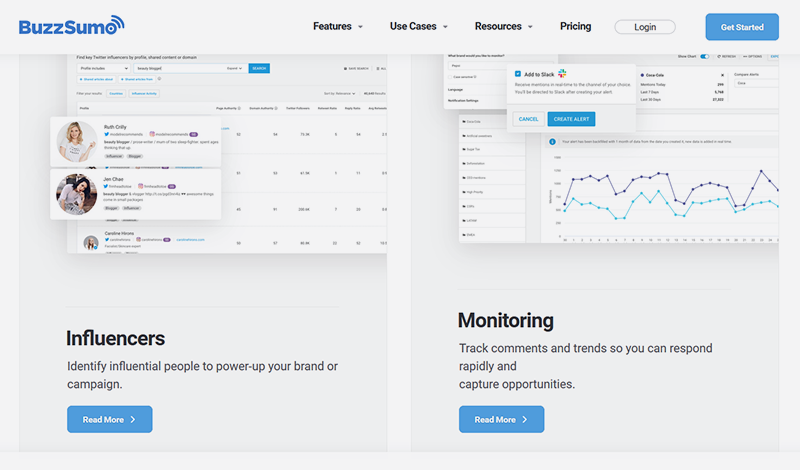
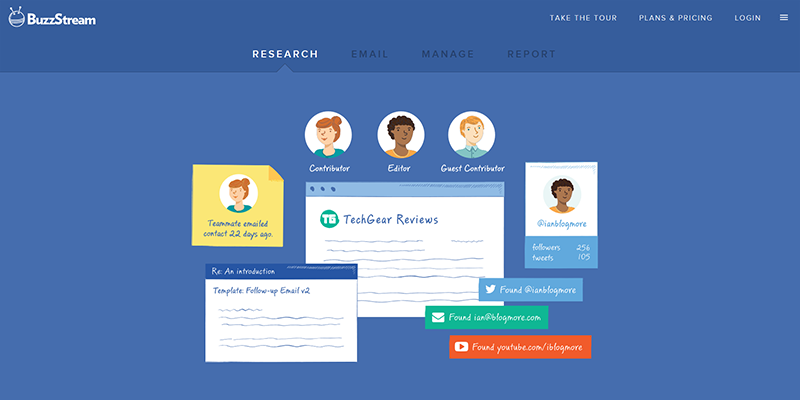
Once you’ve created a list of all your link prospects, you need to prioritize them by domain metrics, social authority, and relevance.
You can easily prioritize your link prospects directly within BuzzStream - the tool allows you to prioritize your prospects by DA, relevance, the number of followers (on relevant social media channels), etc. But if you’re looking for a free alternative, you can create a simple Excel/Google Sheet spreadsheet (note that the process is not as sophisticated and will require a lot more effort on your side).
For example, if you’re targeting Instagram influencers, your Excel/Google Sheet table can contain the following columns: Instagram handle | Number of followers | Website | Domain authority | Relevance
Note: In the example above, “Website” refers to the influencer’s blog. If you decide to reach out to specific website owners (who aren’t influencers, but a link from their website would drive a ton of targeted traffic to your store), make sure to check their domain metrics - you can use BuzzStream or MozBar to achieve this. Both options are paid. If you’re on a shoestring budget, SEOquake is a good free alternative.
Step 4: Find the perfect incentive
In other words, define what you’ll offer in exchange for a backlink. It can be anything from creating the content yourself to a discount or complementary products. You can also start an affiliate program, i.e., offer the influencers a percentage of every sale you made thanks to them, i.e., orders placed by customers they drove to your store.
But the important thing to remember here is to focus on the long-term benefits, i.e., instead of focusing on getting one backlink from one influencer, start a meaningful conversation and build a valuable partnership that results in countless backlinks, giveaways, and more. This starts with your outreach email.
Step 5: Craft a kick-ass outreach email (Best practices)
- You’re reaching out to a person. So, start a real conversation that sounds genuine and honest. Use plain language. Keep your tone friendly. Be respectful.
- Introduce yourself and your brand.
- State your request clearly. Be specific and give details.
- Say why you’re reaching out to them. Tailor your message to each influencer. Is there something specific you like about their blog (e.g., their views on preserving the environment, how they speak to their audience, or even how they edit their photos)? Personalization is the secret ingredient to a successful link building campaign - it helps you stand out in someone’s crowded inbox and makes your emails more engaging and effective.
- Say what the influencer will get in return for the backlink.
- Encourage them to ask questions and answer all of them - this will give you credibility and help you build a stronger connection.
- Create a professional email signature that contains your name, store URL, business pages, and email address.
Ultimately, your goal is to build valuable long-term business relationships with the influencers you contact. And these relationships, like good friendships, are nurtured through continuous caring conversations.
Step 6: Create effective follow-up sequences
According to a detailed email outreach study (conducted by Backlinko and Pitchbox), only 8.5% of outreach emails receive a response. However, one follow-up email can “boost replies by 65.8%,” and reaching out to multiple influencers multiple times can “boost response rates by up to 160%”.
This means that you should always send at least one follow-up email to the influencers who didn’t respond to your initial email.
Here are some of the best practices for creating effective follow-up sequences:
- Don’t be pushy.
- Don’t send your outreach email again. Instead, provide additional information and give more context.
- Subtly explain how collaborating with you would benefit the influencer.
- Keep track of your communication. Otherwise, you might end up requesting a backlink from someone who already agreed to work with you. Not good. BuzzStream can help you stay on top of all your conversations - you can save emails and tweets, automate your follow-up emails, and set follow-up reminders. Learn more
Step 7: Learn how to deal with negative replies
When you reach out to people with a request, you’ll hear “No” instead of “Yes” more often than not. This is why knowing how to deal with negative replies is essential.
Ultimately, you always have to reply. Be polite, respectful, and keep a professional tone. Try to find out why the influencer didn’t want to work with you and take notes. Find if there’s something you did wrong or if there’s something you can adjust to get better results in the future.
Now, before we move on to the next section of the guide - E-A-T, - let’s do a quick recap of the most important link building takeaways:
- Set clear goals for your link building campaign
- Identify the right collaboration opportunities - reach out to relevant influencers with high social authority/website metrics
- Send personalized outreach emails (and always follow-up on them)
- Build a diverse, natural, and relevant link profile (don't pay for backlinks, don't participate in link schemes, etc.)
E-A-T
Note: If you already know what E-A-T is and why it is important, feel free to skip the introduction and move straight to → How can I improve my nopCommerce store’s E-A-T?
E-A-T stands for Expertise (of the creator of the content), Authoritativeness (of the creator of the content, the content, and the website), and Trustworthiness (of the creator of the content, the content, and the website). You can find the definition of E-A-T in Google’s Quality Raters Guidelines (QRG).
What do you need to know about E-A-T?
- “High E-A-T medical advice should be written or produced by people or organizations with appropriate medical expertise or accreditation” - QRG, p.19. This concerns you if you sell food supplements, or pet health products, for example. It means that experts in the field should write your product descriptions and articles. Their credentials should be listed in their author’s bios.
- “High E-A-T information pages on scientific topics should be produced by people or organizations with appropriate scientific expertise” - QRG, p.20. This concerns you if you sell skincare products and publish articles on how they’re made, their ingredients, and their impact on the skin, etc.
- “High E-A-T advice pages on topics such as home remodeling (which can cost thousands of dollars and impact your living situation) or advice on parenting issues (which can impact the future happiness of a family) should also come from “expert” or experienced sources that users can trust” - QRG, p.20. This concerns you if you sell furniture or home decor and offer additional services such as interior design services, planning, 3D modeling, etc. Ensure everything is transparent and clearly written.
- “High E-A-T pages on hobbies, such as photography or learning to play the guitar, also require expertise” - QRG, p.20. This concerns you if you sell photography gear or musical instruments, as well as other products that could be considered “hobbies,” such as snowboards, skis, climbing gear, camping gear, sailing gear, sports equipment, etc.
- High E-A-T articles shouldn’t contain factual errors. The content should be written to help readers gain a better understanding of the topic at hand.
- High E-A-T pages must be relevant and up-to-date. This means that they must be maintained and updated regularly.
Google’s advice is to take a closer look at your pages and think about their topics. Ask yourself: Does this page require expertise to achieve its purpose? If yes, what kind of expertise? Some pages require more expertise than others.
Because different types of websites and webpages can have very different purposes, our expectations and standards for different types of pages are also different.” (QRG, p.8)
Important note: In some cases, the content doesn’t have to be written by an expert for the page to have high E-A-T. Google also values genuine “everyday expertise” on YMYL (Your Money, Your Life) topics. This is stated in Google's QRG, p.20.
How can I improve my nopCommerce store’s E-A-T?
As you’ve probably already guessed, E-A-T is an important off-page ranking signal. Since e-commerce is a YMYL niche, you must make sure your website has high E-A-T. And you should pay extra attention if you sell healthcare products, including food supplements, skincare products, pet food and health supplements, home remodeling supplies and furniture, and more.
There are many things you can do on-site to improve your E-A-T - from small adjustments like adding authors’ bios and credentials to long-term efforts like producing high-quality content. You must also have an SSL certificate, an impeccable About page, and an intuitive Contact page. All these things tell Google whether your website is trustworthy and authentic.
However, when Google measures your store’s E-A-T, off-page SEO factors play a major role as well. The two most important off-page SEO factors that affect your website’s E-A-T are (1) brand mentions and backlinks on authority sites (and their social media profiles) and (2) reviews on social media platforms and Google.
We already covered the link building part of the equation. Now, let’s have a look at how you can encourage your customers to leave positive reviews on social media and Google. Here are our top tips:
- Offer flexible shipping options and easy returns - this will keep your customers happy, and customer satisfaction is the fuel of positive reviews!
- Provide stellar support - Reply to all customer queries promptly. Make sure to address all their issues. Encourage customers to leave reviews on social media if they liked your products or service. Be straightforward and honest - this approach has proven to be highly effective. To increase your chances of getting a review, you can offer something in return, such as a small discount or free shipping on their next order.
- Encourage Facebook reviews - again, you can use an incentive, or you can host a giveaway. Not only will this improve your E-A-T, but it will also give you more exposure to potential customers. Let me explain further - if Jane leaves a positive Facebook review of your store, the Facebook algorithm will probably show her review to her friends. And, since people are likely to trust a brand more if they know their peers already love it, your chances of making a sale are much higher. So, there’s also an added benefit of making more sales.
- Make it easy for your customers to leave a review - on your website, add links that lead customers straight to the page where they can review your products/business. Get creative with your CTA. For example, instead of saying “Tell us what you think” or “Leave a review,” you can say “Help us become better” or “We want to hear from you.” Note: To go the extra mile, send your customers an email encouraging them to leave a review. Depending on the delivery options you offer (and how long delivery usually takes), you can send the email a week after the “Order confirmation” email or several days after the “Order delivered” email. Again, write an engaging subject line (that ensures they open your email) and offer an incentive (that ensures they leave a review).
- Always encourage customers to leave “a review.” Never say “a good review.” This is essential.
- Always say “Thank you.” First and foremost, thank your customers for placing an order and trusting your brand. Second, thank them for leaving a review. Don’t be discouraged if the review is negative. Instead, use the review as an opportunity to grow and improve your products, services, the way you communicate with your customers, and more.
- Talk to your team. Ensure they understand why reviews are important and show them how to encourage customers to leave reviews.
- Don’t participate in review schemes. Fake reviews won’t do you any good. On the contrary, they’ll undermine your credibility and hurt your rankings.
Note that this is just a brief overview of how you can encourage more social media reviews and get higher E-A-T. E-A-T is a broad topic, and if you want to learn more about it, we recommend reading Google’s QRG.
Next, let’s look at the third pillar of off-page SEO for nopCommerce - social signals.
Social signals
Social signals are human interaction metrics on social media (e.g., Facebook, Instagram, Twitter, LinkedIn, Pinterest, etc.). These include the number of followers, likes, shares, reactions, comments, link clicks, pins, mentions, hashtag engagement, and more. Simply put, social signals indicate how well your social media posts perform. Google also uses them as off-page SEO signals, which means that they also affect your SERPs rankings.
So, how can you make your posts more shareable? How can you gain more followers, encourage more comments, etc.?
Crafting a bullet-proof social media strategy is a must. But here are some of the best practices for getting more engagement:
- Create awesome content and share it on social media. Write engaging copy and ask questions that invite customers to start conversations in the comments.
- Share amazing visuals - from awesome banners to fun GIFs and inspiring videos - visual content is one of the biggest reasons people share content online.
- Run giveaways. This will help you gain more followers, get more comments, and more exposure.
- Start UGC (User-generated Content) competitions. This can turn out to be a huge success (especially after a long-awaited product launch).
- Leverage polls to encourage engagement simply and effectively.
- Use every opportunity to start a conversation with your audience. For example, if you share photos from a new photoshoot, share a fun backstage photo and write an anecdote to go with it. Ask customers if something similar happened to them. Make them feel like a part of your brand’s family.
- Host Instagram lives and Twitter chats.
Simply put, be there. Put in continuous effort. Every day. Every minute. Have a plan in place and keep the big picture in mind. Don’t be too serious. Instead, focus on building a brand presence that matches your brand’s voice, highlights your product’s best features, and has a personality. Be honest and be consistent - this is key.
You don’t have to overdo it. You just need to create your posts with care. Dress up your fun and original ideas in impeccable grammar and engaging visuals, and you’ll never go wrong.
Just be you. And be there.
Brand signals
Google uses brand signals to determine if your brand is legit. Brand signals include:
- Branded searches on Google (the number of people who search for your brand on Google). You can get this information using the Google Keyword Planner or the Google Search Console Performance Report.
- Branded searches on YouTube. If you don’t have a video marketing strategy in place, this metric will most likely be lower. If you want to improve it, you should create a YouTube channel and start uploading videos. If you have the resources, the possibilities are endless - you can make product explainer videos, backstage photoshoot videos, upload video testimonials, create video ads, inspiring brand introductions, fun videos from your office or office gatherings, and more. But remember - even if you’re on a shoestring budget, you can still get started with YouTube videos. All you need is a good light ring, a good phone camera, a pinch of talent and creativity, and something to say.
- The number of people who talk about your products and brand on social media groups and forums. Note: Having popular social media accounts (that get a ton of engagement) can also be considered a Brand signal. So, if you haven’t already done it, read the section on Social signals to learn how you can improve your social media presence, gain more followers, and encourage more engagement.
- The number of news sites and blogs that mention your brand (including the comment sections). Note: You can set up brand tracking to find out the exact number. You can use a tool like Mention.

Conclusion
As you can see, off-page SEO is a broad topic. We hope this article will give you the knowledge (and the courage) to get started.
We covered the basics - link building, E-A-T, social signals, and brand signals. We talked about different aspects of these topics, shared some examples and several helpful tools.
If you’d like us to go into more details about off-page SEO and the different factors Google takes into account, please let us know in the comments! Also, feel free to ask us anything related to off-page SEO or nopCommerce.




